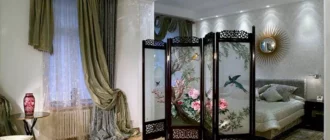
Provence interior design style- the charming charm of the French countryside
Provence is an interior design style characterized by the predominance of light pastel shades and the presence of a large number of floral arrangements in the design of the decor. This style is conducive to a relaxing break from the daily hustle and bustle away from the noise of the big city. Provence is the warmth and comfort of a home, the charm of French antiquity and the elegance of a carefree rural life.


Style Features
Provence is a style in which there is no place for ostentatious luxury and deliberate functionality of the interior. On the contrary, the atmosphere in the room looks natural, discreet and light.

The distinctive features of the style include the following nuances:
- Light, whitewashed or wallpapered with delicate floral ornaments walls.
- Large wooden windows with white frames and houseplants in pots on the windowsills.
- Antique or artificially aged wooden furniture without any frills.
- A large number of forged elements in the design of rooms.
- The floors are parquet, laminate or ceramic tiles in light shades.
- Chandeliers, floor and wall lamps with fabric shades.
- Lightly drape windows with tulle or translucent natural fabrics.
- A variety of textiles (pillows, bedspreads, tablecloths) with printed patterns and lace.
Provence-style ceilings are usually painted white, and the protruding wooden beams are dark brown for contrast. Stucco is rarely used, and floral motifs predominate in the design of the walls.

The main decor is all kinds of live and dried plants.
They are placed in a variety of places:
- in vases on tables and cabinets;
- in hanging planters;
- in flower pots on the floor and window sills.


Ceramic dishes are also often used as decoration. The walls of the rooms are often decorated with paintings depicting rural landscapes, photographs and mirrors in wrought iron frames.
A simple homespun rug or a small carpet with a floral pattern harmoniously looks on the floor of the room. The cozy atmosphere of the room is complemented by a small fireplace and wicker chairs made of natural rattan.
An important advantage of Provence is considered to be its accessibility. Even small apartments or country houses are ideal for arranging housing in the style of a French village. To create a charming environment, their owners do not need to spend fabulous sums on repairs. It is enough just to entrust the development of the project to a good designer and bring it to life.

Provence style history
The history of Provence dates back to the second half of the 17th century. At this time, in the capital of France, the Baroque style began to rapidly gain popularity in various fields of art. Representatives of the upper strata of society bathed in luxury, which was fully consistent with the exquisite furnishings of houses and palaces.
At the same time, in the southeastern French provinces, the life of the local nobility remained calm and cloudless. Wealthy people did not try to keep up with the fashion of the capital, but equipped their housing unpretentiously and comfortably. Ideas for interior design were prompted by nature itself. The lightness and airiness of small hospitable houses fit perfectly into provincial life.


Provence remained a typical rustic interior style until the middle of the 19th century, but then the situation changed. The rapid development of industry has left its mark on the lifestyle of urban residents. Many of them wanted to get away from the daily bustle and live at least a little in the countryside. It was the Parisians who first began to equip their country houses in the Provence style.
By the end of the 19th century, the popularity of Provence was no longer limited to France. The simplicity and lightness of this style appealed to residents of various European countries. His supporters appeared in Germany and Austria, Russia and Italy, Switzerland and Holland.


Provence has withstood the test of time well into the 20th century. Despite the emergence of a huge number of new styles, it has retained its appeal to millions of people around the world. In the 21st century, Provence has a solid army of supporters, for whom the main criterion for choosing a design is the creation of an atmosphere of comfort and peace in the house.



























